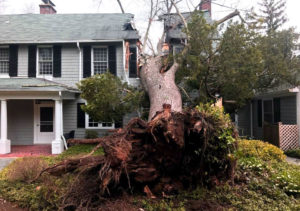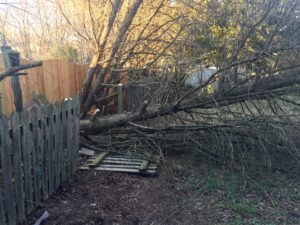When should you file a claim after a storm?

The answer to this question is quite easy actually. Insurance policies are designed to insure your property against CATASTROPHIC LOSS. AKA, when you see it, you will certainly know when to file a claim. In the above example, it is quite obvious that a claim should be filed.
I would also like to be very clear that this advice is not to replace the relationship between you and your agent or the insurance company. Each company offers a different policy, and case law will force insurance companies to operate differently in the years to come.
Now that you are still here and interested in some nuance- The hard part of this question is when there is some damage but is it WORTH IT? Let’s start with a tough example.
Scenario 1

In this situation, we have a neighbors tree that has damaged 8 ft of fencing. Our client’s knee jerk reaction is that the damage is minimal, and they decided to not file a claim. After trying to find a tree removal company, they are quoted $1,000 dollars to remove the tree to take the debris off the property. The fencing company wants a minimum of $600 dollars to use their team for a small job.
- What is my deductible?
- Most deductibles fall under $1000, $1500, $2500.
- Will I lose a discount?
- Most policies are carrying a no claim discount.
- Is this claim worth losing a discount for your annual premium and the cost of the deductible?
- What will the policy pay for?
- First- Call your agent.
- If you still haven’t done so, let me try to break this down.
- Insurance companies want to pay for as little as they can to settle a loss.
- Repair first. Just because it will not match, does not change the insurance companies’ interest or obligation. At most, you will get money to stain/paint that one side.
- Fences are not a structure, thus not considered for replacement cost. If an entire run of fencing needs to be replaced, they will take the cost to replace that entire run, then depreciate it by its age.
- This PLUS the loss of a no claim discount, and deductible needs to be taken into consideration.
- Debris removal is capped. That’s right, how much should it cost to remove the tree from the covered property. In the example above, it’s likely to be $200 of the $1000 quoted. The rest is labor to cut up the rest of the tree and haul off. Your insurance company will likely have a SUB LIMIT for debris removal. Most of the time it is $500 dollars.
- This is for examples like the first picture, where taking the tree off the house is $5000, and then cutting up the rest of the tree is another $5000.
- In the above example, the insurance company would pay the first $5000 to take the tree off the house, and $500 for the rest of the tree, leaving you with a bill of $4500.
- Some additional nuance- there is a term called absorbing the deductible which means if you suffer the cost of the $4500, it would go toward your deductible so you are not paying the deductible plus $4500.
- In the above example, the insurance company would pay the first $5000 to take the tree off the house, and $500 for the rest of the tree, leaving you with a bill of $4500.
- This is for examples like the first picture, where taking the tree off the house is $5000, and then cutting up the rest of the tree is another $5000.
- CALL YOUR AGENT. There is so much that goes into the insurance contract, that no matter how much education I can provide, working with your agent will yield the best results since each situation is so different.
- Insurance companies want to pay for as little as they can to settle a loss.
Scenario 2

In this scenario, a neighbors tree has fallen and damaged the client’s deck. Fortunately, there is no damage to the home. The cost to remove the tree off the deck and chop up the tree is $600 dollars. Repairs to the deck include repairing the handrail, fascia board, and repainting the deck. This was estimated to cost $1000.
The general rule of thumb is that if the tree is touching the house, you should file a claim. This is the situation where speaking with your agent would be wise prior to file a claim. Take into consideration the above example and apply it here.
- What is your deductible and will you lose a discount?
- If the damages are $1600 and you have a $1000 dollar deductible, consider the loss of discount prior to filing a claim.
- Just because the scope of work exceeds the deductible, it still might not make financial sense to file the claim.
In all honesty- the better question is that should the neighbor be responsible for the damages? This tree appears to be old, without greenery like the tree behind it. If you have put your neighbor on notice about the tree, your insurance policy would likely subrogate for the damages- yet also note that they can only sue for what they paid. If you carry a $2500 dollar deductible, this might be just a case where you eat the cost and take your neighbor to small claims court if they do not feel like they owe to help with the cost.
Many agents will hesitate to offer this kind of advice if they are even familiar at all with the policy or how claims would handle a loss. This is especially true if you are partnered with an insurance company that works direct, such as Progressive direct. In order to speak with a licensed adjuster, you will need to file a claim, and all of this nuance was for not. If an adjuster shows up, and you do not like the outcome, it is still a claim.


